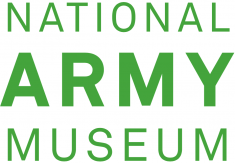
The volunteers visited the National Army Museum for a training session on the Siborne Model and the source letters used to create it. Megan Perry reflects…
The newly revamped National Army Museum is a sight to behold. Inside, the three stories are modernly decorated and aesthetically pleasing. Wandering around, visitors can find something they are interested in, no matter their age or tastes. The museum houses artefacts dating back to the late 18th century with the American Revolution up until the more recent wars in Iraq and Afghanistan. The museum also puts forth many interactive exhibits that are incredibly fun for children and adults alike that span from uniforms and military procedure to media perceptions of the military.
 One of these interactive exhibitions portrayed the Battle of Waterloo, which was extremely relevant to the Samuel Godley project the Westminster Archives staff and volunteers have been working on. On the upper level of the museum, nestled in a corner, was the Siborne Model. This large topographical map portrayed the landscape and geography of the area in which the battle was fought. There are also interactive tablets that visitors can use to better see the formation the French and English forces took on the field. This exhibition really helped me get a better sense of the vastness of the area fought, including the emptiness. The soldiers, including Samuel Godley, were far from food, family, and medical attention, which could only have increased the stresses of war.
One of these interactive exhibitions portrayed the Battle of Waterloo, which was extremely relevant to the Samuel Godley project the Westminster Archives staff and volunteers have been working on. On the upper level of the museum, nestled in a corner, was the Siborne Model. This large topographical map portrayed the landscape and geography of the area in which the battle was fought. There are also interactive tablets that visitors can use to better see the formation the French and English forces took on the field. This exhibition really helped me get a better sense of the vastness of the area fought, including the emptiness. The soldiers, including Samuel Godley, were far from food, family, and medical attention, which could only have increased the stresses of war.
 Just across the way, there is another case complete with artefacts from the Battle of Waterloo and the period surrounding it. I enjoyed viewing the uniforms and weaponry that helped me better understand the daily life of a soldier at that time. In the same case, there are also busts of the leaders of the battle, including the Duke of Wellington. While we can’t be completely sure this is true to his exact appearance, it gives an idea of what this important figure in history looked like.
Just across the way, there is another case complete with artefacts from the Battle of Waterloo and the period surrounding it. I enjoyed viewing the uniforms and weaponry that helped me better understand the daily life of a soldier at that time. In the same case, there are also busts of the leaders of the battle, including the Duke of Wellington. While we can’t be completely sure this is true to his exact appearance, it gives an idea of what this important figure in history looked like.




No Comments
Add a comment about this page